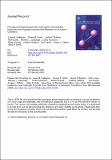| dc.contributor.author | Gallagher, Laura B. | |
| dc.contributor.author | Dolan, Eimear B. | |
| dc.contributor.author | O'Sullivan, Janice | |
| dc.contributor.author | Levey, Ruth | |
| dc.contributor.author | Cavanagh, Brenton L. | |
| dc.contributor.author | Kovarova, Lenka | |
| dc.contributor.author | Pravda, Martin | |
| dc.contributor.author | Velebny, Vladimir | |
| dc.contributor.author | Farrell, Tom | |
| dc.contributor.author | O'Brien, Fergal J. | |
| dc.contributor.author | Duffy, Garry P. | |
| dc.date.accessioned | 2020-03-13T12:09:43Z | |
| dc.date.issued | 2020-03-04 | |
| dc.identifier.citation | Gallagher, L. B., Dolan, E. B., O'Sullivan, J., Levey, R., Cavanagh, B. L., Kovarova, L., Pravda, M., Velebny, V. Farrell, T., Duffy, G. P. (2020). Pre-culture of mesenchymal stem cells within RGD-modified hyaluronic acid hydrogel improves their resilience to ischaemic conditions. Acta Biomaterialia. doi:https://doi.org/10.1016/j.actbio.2020.02.043 | en_IE |
| dc.identifier.issn | 1878-7568 | |
| dc.identifier.uri | http://hdl.handle.net/10379/15847 | |
| dc.description.abstract | The incorporation of the RGD peptide (arginine-glycine-aspartate) into biomaterials has been proposed to promote cell adhesion to the matrix, which can influence and control cell behaviour and function. While many studies have utilised RGD modified biomaterials for cell delivery, few have examined its effect under the condition of reduced oxygen and nutrients, as found at ischaemic injury sites. Here, we systematically examine the effect of RGD on hMSCs in hyaluronic acid (HA) hydrogel under standard and ischaemic culture conditions, to elucidate under what conditions RGD has beneficial effects over unmodified HA and its effectiveness in improving cell viability. Results demonstrate that under standard culture conditions, RGD significantly increased hMSC spreading and the release of vascular endothelial factor-1 (VEGF) and monocyte chemoattractant factor-1 (MCP-1), compared to unmodified HA hydrogel. As adhesion is known to influence cell survival, we hypothesized that cells in RGD hydrogels would exhibit increased cell viability under ischaemic culture conditions. However, results demonstrate that cell viability and protein release was comparable in both RGD modified and unmodified HA hydrogels. Confocal imaging revealed cellular morphology indicative of weak cell adhesion. Subsequent investigations found that RGD was could exert positive effects on encapsulated cells under ischaemic conditions but only if hMSCs were pre-cultured under standard conditions to allow strong adhesion to RGD before exposure. Together, these results provide novel insight into the value of RGD introduction and suggest that the adhesion of hMSCs to RGD prior to delivery could improve survival and function at ischemic injury sites. | en_IE |
| dc.description.sponsorship | AMCARE project funded by European Union‟s „Seventh Framework‟ Programme for research,
technological development and demonstration under Grant Agreement no. NMP3-SME- 2013-
604531. Laura Gallagher is funded by the Anatomical Society PhD Scholarship. The authors would
like to thanks Dr Joanne O‟Dwyer for her assistance and acknowledge the support of the Centre of
Microscopy and Imaging (NUI Galway). The authors would also like the acknowledge the following
grants for use of the hMSCs described in this publication; 09/SRC/B1794 REMEDI grant from
Science Foundation Ireland and “PurStem” and FP7 European Union Health Collaborative Project,
EU FP7-HEALTH-2007-B, PurStem, grant no 223298 | en_IE |
| dc.format | application/pdf | en_IE |
| dc.language.iso | en | en_IE |
| dc.publisher | Elsevier | en_IE |
| dc.relation.ispartof | Acta Biomaterialia | en |
| dc.rights | Attribution-NonCommercial-NoDerivs 3.0 Ireland | |
| dc.rights.uri | https://creativecommons.org/licenses/by-nc-nd/3.0/ie/ | |
| dc.subject | Mesenchymal stem cell | en_IE |
| dc.subject | RGD | en_IE |
| dc.subject | Myocardial infarction | en_IE |
| dc.subject | Hyaluronic acid | en_IE |
| dc.subject | Stem cell delivery | en_IE |
| dc.subject | Hydrogel | en_IE |
| dc.title | Pre-culture of mesenchymal stem cells within RGD-modified hyaluronic acid hydrogel improves their resilience to ischaemic conditions | en_IE |
| dc.type | Article | en_IE |
| dc.date.updated | 2020-03-12T10:39:09Z | |
| dc.identifier.doi | 10.1016/j.actbio.2020.02.043 | |
| dc.local.publishedsource | https://doi.org/10.1016/j.actbio.2020.02.043 | en_IE |
| dc.description.peer-reviewed | peer-reviewed | |
| dc.contributor.funder | Seventh Framework Programme | en_IE |
| dc.contributor.funder | Anatomical Society PhD Scholarship | en_IE |
| dc.contributor.funder | Science Foundation Ireland | en_IE |
| dc.description.embargo | 2022-03-04 | |
| dc.internal.rssid | 20188183 | |
| dc.local.contact | Eimear Dolan, Biomedical Engineering 3031, College Of Engineering & Informa, Nui Galway. Email: eimear.dolan@nuigalway.ie | |
| dc.local.copyrightchecked | Yes | |
| dc.local.version | ACCEPTED | |
| dcterms.project | info:eu-repo/grantAgreement/EC/FP7::SP1::NMP/604531/EU/Advanced Materials for Cardiac Regeneration (AMCARE)/AMCARE | en_IE |
| dcterms.project | info:eu-repo/grantAgreement/SFI/SFI Strategic Research Cluster/09/SRC/B1794/IE/SRC REMEDI: REMEDI-2: From Research to Human Therapy/ | en_IE |
| dcterms.project | info:eu-repo/grantAgreement/EC/FP7::SP1::HEALTH/223298/EU/Utilisation of the mesenchymal stem cell receptome for rational development of uniform, serum-free culture conditions and tools for cell characterization/PURSTEM | en_IE |
| nui.item.downloads | 200 | |


